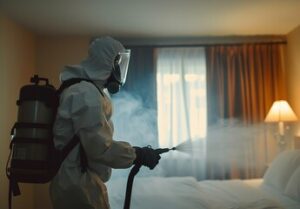Pests damage houses and businesses. They carry pathogens and allergens that can cause disease in people and pets. They also cause structural damage and destroy furniture and other belongings.

In the past, exterminators focused on eradicating the pests using harsh chemicals. Today, pest control experts take a more holistic approach to managing pests. They look at the hows and whys to prevent future infestations from occurring. Contact Pest Control Abbotsford BC for professional help.
It is important to correctly identify the pests that are causing damage to your home or crops. This is because different pests require a unique treatment method. For example, ants can be controlled with insecticides but cockroaches and wasps require bait products. It is also necessary to know what type of habitat the pests are in order to take steps to prevent them from entering your property.
Insects can cause extensive damage to agricultural crops. They can also cause structural and cosmetic damage to buildings and homes. They can also carry diseases and contaminate food. It is therefore essential to have a pest control expert in as soon as you see any signs of pests. The longer you wait to call a professional, the more damage will be done.
Pest identification can be difficult because of the variation in appearance as the pest goes through its life cycle. For example, an immature beetle can look like a caterpillar or worm and vice versa. This is why it is important to have a pest control expert that can use a variety of methods to identify the pests.
When it comes to commercial pests, it is especially important to have a thorough understanding of the pest’s biology. This allows the pest control expert to develop a targeted approach to control the pest. For example, the correct identification of crop-damaging insects can lead to better decisions about pesticide applications and timing. In addition, it is often easier to target specific organisms with a targeted application when the pest is identified to species level.
While it may not always be feasible to identify a pest down to the species, it is a good idea to keep a file of digital images of the pests that are encountered in the field. This can help to make the process of identifying pests and beneficials easier in future years.
It is also a good idea to keep records of where the pests were found, what the weather was like that day and any other information that might be relevant to the problem. This can be helpful in determining whether or not the problem is caused by environmental conditions and needs to be addressed by other means rather than an insecticide.
Pest Prevention
Pests are a nuisance and can cause damage to property, stock and equipment. They also can threaten human health by transmitting diseases and creating unhygienic conditions. Regular pest control can protect a business’s reputation and reduce ongoing maintenance costs and operational downtime. Pest infestation can have a significant impact on commercial premises and lead to closure under health and safety legislation, so it’s essential that the issue is dealt with quickly and effectively.
Pest prevention measures include exclusion and reducing available food and shelter for pests. Exclusion involves sealing cracks, gaps, crevices and other openings around doors, windows, vents and other structural components. It also includes the use of screens on window and door frames and the application of caulking to prevent entry. Reducing the availability of food and shelter for pests involves keeping garbage receptacles away from buildings, keeping spaces under storage clean and dry and storing materials in tightly-sealed containers. It also includes the use of deterrents to ward off pests, such as repellents, traps and physical barriers. Identifying the pests, their life stages and habitats is vital to assessing the need for control and designing effective management strategies. This information allows the selection and timing of appropriate control methods.
A key aspect of pest prevention is understanding the role played by a building’s physical condition, ecology and cultural practices in attracting and harboring pests. This information can be used to assess a facility and make recommendations for improvement.
The effectiveness of a pest control program is also influenced by knowing the lifespan and behavior of the target pests, their preferred food sources, and the factors that influence their movement and nesting habits. Knowledge of these influences can help in the design and monitoring of an integrated pest management (IPM) program.
A good IPM program is based on an assessment of the need for pest control and uses methods that are both environmentally sound and humane. It starts by determining whether the problem is serious enough to require intervention and by identifying the pest responsible. Using an accurate pest identification chart helps ensure that the correct control method is applied at the right time. This is important because the ability of different control methods to control a particular pest depends on whether it is in its egg, larval, nymphal or adult stage.
Pest Control Methods
Pest control has a wide range of methods. Preventive practices include keeping work and living areas clean, sealing cracks in walls and foundation, removing debris that can harbor pests, trimming branches away from buildings, maintaining garbage and food containers sealed, and using hygienic practices when preparing meals. This helps prevent pests from entering the home and enables them to be easily treated by professional pest control services.
Chemical controls are used to kill or repel pests. They can be natural or synthetic and may be in a liquid, solid, or aerosol form. Many are harmful to humans and other living things, so they should be used only when needed and never without proper protection.
Biological and cultural pest control methods help reduce the need for chemicals by altering environmental conditions that support pest populations. Classical biological control introduces non-native natural enemies, such as predators and parasitoids, into the environment to injure or consume target pests, thereby controlling them. These natural enemies must be chosen carefully to ensure they won’t harm native species.
Other biological and cultural control methods include crop rotation, soil amendments, and adjusting irrigation patterns. These methods can significantly reduce the need for chemical treatments, if implemented correctly.
Chemical pest control is most effective when it is applied early in an infestation. If pests are allowed to reach threshold levels, control will be more difficult, less effective, and possibly too late to prevent damage.
To detect pest problems before they become severe, scout or monitor plants frequently, understand the biology of the pest, and recognize damage symptoms. Monitoring methods for insect, mollusk, vertebrate, and weed pests generally involve trapping or scouting.
When determining whether to use preventive or chemical pest control, you need to consider the costs and benefits of each. Preventive measures are economical and environmentally responsible, and they can significantly reduce the need for more costly and dangerous chemical controls. However, if pests cause significant economic or health damage, it may be necessary to employ other controls. In this case, you should set an action threshold and define desired outcomes to guide your pest management efforts.
Pest Control Cost
One of the first questions people ask when seeking pest control services is how much it will cost. Pest control costs vary depending on the type of pest and the size of the home or business. The initial treatment is the largest expense, followed by maintenance services and cleaning and sanitization. The severity of the infestation is another significant factor in pricing. A severe infestation will require more treatments and may require more extensive treatment methods, such as fumigation.
Regular pest control is an essential investment in your family’s safety, health, and well-being. It protects property from damage and loss and enables you to sell or rent it for maximum value. It can also save you considerable money by preventing costly repairs from untreated pests.
Rodents can cause significant damage to your home. They can chew through wires and other vital materials, damage your home’s structure and insulation, and create fire hazards. They can also bite and spread disease. Regular pest control prevents rodent problems and catches them before they become severe, saving you expensive repair bills.
Termite inspections and treatments are essential to avoid costly repairs and loss of your home’s value. The CDC estimates that yearly costs of a termite infestation are more than $15 billion in the States. Other pests can also cost homeowners or businesses significantly. Pests can damage reputations, which can lead to financial loss in restaurants, hotels, and other hospitality facilities. They can also affect the sale or rental of homes and businesses, leading to lost revenue and potential legal issues.
Pests can cause significant damage and loss, leading to serious health and safety risks for your family or employees. It is important to seek professional help from a reputable pest control company, which will provide an honest evaluation of your situation and recommended solutions. Look for a local company with years of experience and a team of experts who are familiar with the pest pressures in your area. They should be licensed, insured, and offer a wide range of pest removal and prevention options, including eco-friendly treatment alternatives.
